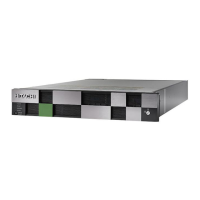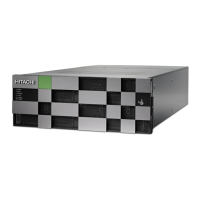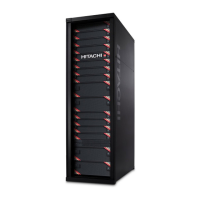Do you have a question about the Hitachi NAS Platform 4000 Series and is the answer not in the manual?
Lists the Hitachi NAS Platform and Hitachi Unified Storage File Module models covered in this manual.
Defines the intended readers of this guide, focusing on owners and field service personnel.
Explains the typographical and message conventions used throughout the document for clarity.
Guidelines to prevent hardware faults caused by electrostatic discharge during handling.
Instructions for safe handling and operation of the equipment to ensure user safety.
Guidelines for safe electrical connections and operation to prevent hazards.
Procedures to ensure data integrity and safe handling of storage components.
Details compliance with various international safety and EMC standards.
Describes the main components housed in the server rack or cabinet.
Provides physical and environmental specifications for the server models.
Explains the importance of vents and fan openings for airflow and preventing overheating.
Describes the removable bezel and front-facing server components.
Details the function of LEDs on the server chassis for status indication.
Explains the function and characteristics of the NVRAM backup battery pack.
Describes the server's internal hard disk drives and their status LEDs.
Details the hot-swappable fan assemblies and their role in cooling.
Identifies ports, connectors, switches, and LEDs on the rear panel of the 4040 model.
Locates status LEDs and buttons on the server's rear panel.
Describes the function and connectivity of 10/100 private Ethernet ports.
Identifies ports, connectors, switches, and LEDs on the rear panels of 4060/4080/4100 models.
Explains the 10 GbE ports used for connecting cluster nodes together.
Describes the dual, hot-swappable AC power supply units (PSUs) and their status LEDs.
Details the types of physical management ports: RS-232 Serial and Ethernet.
Explains the use of the RS-232 port for system setup and management.
Describes the Ethernet ports used for server management purposes.
Identifies components that can be replaced by certified engineers.
Lists components that can be changed without shutting down the server.
Procedure for removing and replacing the server's front bezel.
Step-by-step guide for replacing a server fan assembly.
Instructions for replacing the NVRAM backup battery pack.
Procedures for recovering from disk failures or replacing hard disk drives.
Guide for replacing a hot-swappable power supply unit (PSU).
Instructions for manually restarting or shutting down a server.
Procedures for restarting or shutting down all nodes in a cluster.
Steps to restart a server that is not responding via OS console.
Procedure for powering down a server for extended periods.
Highlights requirements and considerations for replacing server nodes.
Specifies necessary training, authorization, and license keys for replacement.
Details components that must be removed from the old server for reuse.
Guide for manually installing the System Management Unit software.
Procedure for replacing a non-functioning server with an embedded SMU.
Steps to gather essential data from the old server before replacement.
Procedure for preparing the server for removal and shipping.
Steps to configure the replacement server with necessary IP addresses and settings.
Steps to load license keys, verify firmware, and restore system configuration.
Guidance for replacing a server that uses an external SMU.
Procedure for replacing a single node in a two-node cluster configuration.
Steps to physically install and configure the new server node in a cluster.
Procedure for replacing all servers in a cluster if both are non-functioning.
Describes methods to access the server's Command Line Interface (CLI).
Instructions for connecting to the SMU or server via a serial console.
Guidance on accessing the SMU using any SSH client.
| Model | Hitachi NAS Platform 4000 Series |
|---|---|
| RAID Support | RAID 0, 1, 5, 6, 10 |
| Supported Protocols | CIFS/SMB, NFS, HTTP, FTP |
| Maximum Number of Drives | Up to 24 |
| Networking | Gigabit Ethernet, 10 Gigabit Ethernet (optional) |
| Hard Drives Supported | SAS, SATA |











